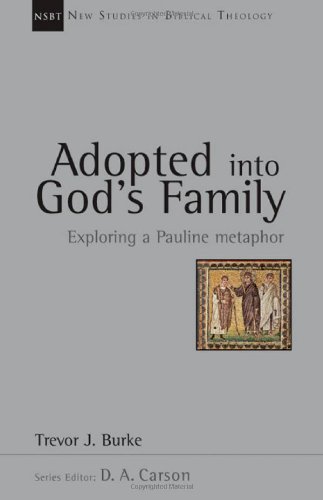A Brief Book Summary from Books At a Glance
By Mitch Chase
Overview
Adoption is an important aspect of the multi-faceted picture of salvation in the NT. Through union with Christ, believers have become sons and daughters of God. The notion of sonship should be understood in light of OT and Roman backgrounds. In Christ, believers have been ascribed a status and privilege which they did not earn but also which they cannot lose. As adopted children, the saints are heirs with Christ of the promises of God. The establishment of sonship and the eschatological outpouring of the Spirit go together hand in hand. Believers must now live out their identity as family members in Christ, living in a present age marked by suffering but also hoping for their physical resurrection and the renewal of all things. Adoption is both inaugurated and anticipated. At the resurrection of the dead, the status of the children of God will be made evident to the world.
Table of Contents
1 Adoption: A Misinterpreted Metaphor?
2 Adoption: Another Soteriological Metaphor for Paul
3 The Origin and Background of Paul’s Adoption Metaphor
4 ‘Abba, Father’ and His Family of Adopted Sons
5 God the Son and the Adopted Sons of God
6 Adoption and the Spirit
7 Adoption and Honour
8 Adoption and Living Between the ‘Now’ and ‘Not Yet’
Summary
Appendix: Some Alleged Cases of Adoption in the OT
Summary
Chapter 1: Adoption: A Misinterpreted Metaphor?
The Old and New Testament authors speak of the relationship between God and his people. Paul’s term “adoption” (huiothesia) has received less attention than other theological terms, and no other NT writer uses it. Huiothesia occurs five times in three Pauline letters (Rom. 8:15, 23; 9:4; Gal. 4:5; Eph. 1:5). Neither the noun nor its verbal form appear in the OT, and the noun is also absent from classical Greek writers and other Jewish literature of Paul’s day. The first appearances of huiothesia are in funerary inscriptions of the second century BC in Adelphi and Crete.
When Paul uses the term “adoption,” it is always metaphorical and never literal. For the apostle, “adoption” is an intimate depiction of what it means to be a Christian. It depicts the new status of the sinner. Some scholars have mistakenly viewed adoption as the positive side of justification, and this confusion was evident when theologians tried to locate adoption in the ordo salutis. When justification and adoption are conflated, the distinctiveness of adoption is lost. Most accurately, adoption is related to justification while nevertheless being a distinct act of God’s grace.
Adoption and justification are not the same. Justification is the righteous status the sinner now has before God. Adoption refers to the incorporation into God’s family and the privilege of calling God “Abba, Father.” God justifies sinners and then adopts them into his household. Adoption is not the same as regeneration. Regeneration refers to the rebirth of the sinner by the unilateral work of God. Adoption is a term denoting the legal act, or transfer, of a sinner into God’s household.
While Bible scholars have shown interest in the Pauline metaphor of adoption, these studies have been too one-sided, focusing mainly on the background of the metaphor. The background of the term is certainly important, but other aspects are overlooked—such as the relationship between adoption and the Spirit.
Chapter 2: Adoption: Another Soteriological Metaphor for Paul
Paul’s use of family terms, especially “adoption,” is clearly metaphorical in his letters. Paul has taken the literal concept of family and made an analogy to Christian relations. A metaphor has a source domain and a target domain. The family unit in the ancient world is the source domain, and the Christian’s relationship to God is the target domain.
Salvation in Paul’s letters is a many-sided reality. The “adoption” metaphor adds a specific nuance to Paul’s soteriology. Adoption centers in the person and work of Jesus, it shares a moral focus that is evident in Paul’s other soteriological. . .
[To continue reading this summary, please see below....]The remainder of this article is premium content. Become a member to continue reading.
Already have an account? Sign In
